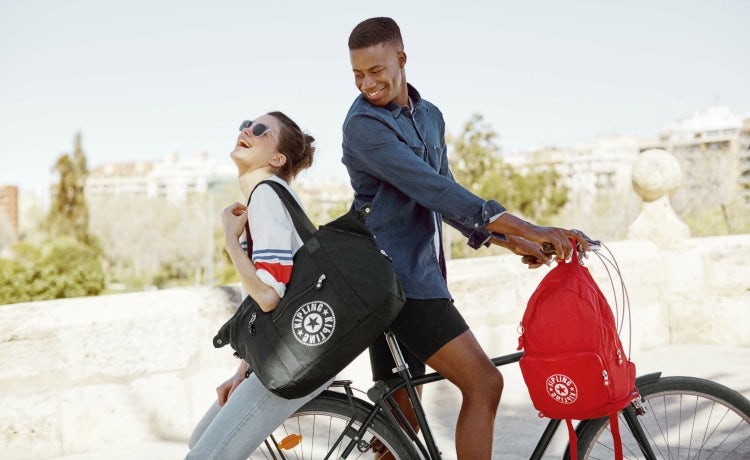Kipling rebrands as it looks to do ‘fewer things, but bigger’
Belgian bag brand Kipling is hoping to ramp up its appeal among millennials by ditching the pink and tapping into an ‘on-the-go’ lifestyle, 30 years since its products first hit the shelves.

After 30 years in fashion Kipling is undergoing a 360-degree rebrand that will see the handbag and accessories label streamline its collection and downsize its signature monkey keychains as it looks to attract a younger customer.
Known for its lightweight fabric bags in a variety of sizes, shapes and colours, Kipling is hoping to give its customer base a boost by targeting the millennial market, developing its relationship with existing consumers and investing in key categories like back to school. The new brand vision will roll out in July across 3,000 points of sale worldwide, with the launch of the autumn/winter 2018 collection and will continue into spring/summer 2019.
Global president Vera Breuer, who joined fashion conglomerate VF Corporation in January to head up Kipling, describes the rebrand as an evolution rather than a revolution. This evolution will involve stripping back the colour palette, revamping the monkey keychain on some styles and focusing on pieces that fit an ‘on-the-go’ mentality.
“I think we’ve been a bit pink in the past and this is not what the heritage of the brand is, so we’ll go from a pink brand to a much more inclusive brand,” Breuer explains.
“We will have the monkeys, which are a very strong element of the brand, but they will be more grown up. It’s really going from a ‘make me happy’ brand, which was really the brand purpose over the past year, to a brand that is not dictating that it wants to make you happy. We are here for the lifestyle of people who are on the move, who are commuting, travelling and discovering.”
In line with the new vision, Kipling’s primary KPI will be attracting new customers and then focusing on consolidating rather than expanding the business. The mantra is “do fewer, but bigger”. To achieve this, Kipling plans to focus more on its essentials business, bringing its ‘icon’ handbags and weekend bags to the fore in-store and online.

“When you go into the store there’s a whole profusion of different shapes, sizes and colours, so our idea is to do fewer, but bigger. We want to concentrate more on our items for the future and not go into too many shapes,” says Breuer of the strategy.
“This will mean really looking at the different categories and in some cases going deeper into the different lines. In others this will mean really refreshing the lines. Others will be more innovative, but there will always be a link to our creative vision and purpose.”
READ MORE: Product innovation or marketing strategy – What comes first?
Catering for the UK
Britain is an “absolutely key market” for Kipling, as it stands out for its willingness to embrace change and lead the latest trends. In order to get this important market right Kipling has consolidated much of its business in the UK over the past year, with the team acknowledging that it had expanded too fast and perhaps not always in the right locations.
In the UK, the right locations are areas where Kipling can keep in close contact with both millennial and international consumers, as well as engage its brand fans, described by Breuer as some of the “most loyal” customers in Europe. The brand is also fully aware it needs to cater to the UK’s love of online shopping if it wants to gain ground.
Customers today wants to experience something and when they make the effort to come to your store there has to be a reason why.
Vera Breuer, Kipling
“Our customers are discovering brands online, they are browsing in-store and buying online, they’re checking out prices and trends, so I think it’s an ecosystem and the one thing you need to make sure is that you’re consistent across the different touchpoints,” Breuer explains.
“I’m definitely someone who is embracing changes and if the customer dictates that they would rather buy the product online then we will act according to that, but I think you have to make sure different touchpoints are not fighting against each other. It is more about becoming a whole part of the ecosystem and this is how we will be approaching the business.”

As global president, Breuer is responsible for delivering brand strategy and helping to define Kipling’s long-term vision, as well as managing product, design and marketing with a view to driving the five-year plan. Prior to taking on the Kipling role she spent the majority of her career working in Asia, managing luxury brands for L’Oréal and serving as general manager for South Asia at The Body Shop.
Her international experience, ability to adapt to the rapidly changing pace of the beauty industry and her appreciation of delivering a seamless customer experience are skills Breuer believes will help her excel at Kipling.
READ MORE: How brands should target Chinese consumers during Golden Week and beyond
“Whatever happens in digital, Asia is 10 years ahead of Europe. Also working a lot with opening markets means there’s lots of entrepreneurship and agility needed and that’s so important in a market like the beauty industry where if you’re not fast you quickly fall behind,” she explains.
“One thing that was really key to win in such a competitive market was working on customer experience and this is something I feel I can bring to Kipling. You see in some locations in the UK customer experience is so key for international travellers, but you need to bring it one step further. It’s simply not good enough having four walls and a normal online shop, customers today wants to experience something and when they make the effort to come to your store there has to be a reason why.”







